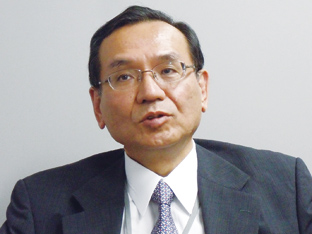
JFE Steel’s senior vice president & executive officer Sadao Ono said the firm tries to offer total solution with advanced technology. The firm accelerates development of new high grade products with value for the users based on the technology advantage in world steel market. The firm tries to contribute to the users’ efficient production process and better products’ value while the firm improves the structural efficiency of steel supply chain management. Through the total service, the firm tries to keep and expand the steel supply.
Mr. Ono said the firm improves the technological service for the users in emerging countries when local users’ requirement gets higher level in emerging countries associated with the economy growth. He said the firm offers technology oriented pragmatic proposal to the users for better operation, management and development at the users’ side. He believes through the effort, the firm can increase the steel supply when such effort wins the users’ trust and contributes to the uses’ better competitiveness. Mr. Ono said the firm could adjust export strategy when yen rate increases for currencies of major countries including China, South Korea, Taiwan and India along with US dollars. The firm established vertical partnership network with offshore partners to secure stable steel buyers. However, he recognizes such partnership network cannot provide reasonable profit for JFE Steel under high yen rate, high raw materials cost and Japanese disadvantage in free trade network. He said the firm studies new supply network through further cooperation with offshore partners and new steel export scheme to utilize other countries’ free trade network. Mr. Ono said the firm expands the partnership with offshore companies in capital participation and technical support. He emphasized the firm utilizes the resource mainly into offshore rerollers and pipe makers with potentiality for high grade steel market. He said through the effort, the firm realized 1 million tonnes of additional steel sales in fiscal 2010 ended March 2011 and the additional volume could be hundreds of thousand tonnes level in fiscal 2011 even under the high yen rate. He said the firm tries to develop the long term partnership. Mr. Ono said ocean freight cost reduction is main challenge especially for export with long distance transport. He said the firm expanded the export shipping capacity at Fukuyama and Kurashiki areas of West Japan Works in fiscal 2010 by adding a shipping crane each. He said the firm tries to minimize the cost in various steps including large lot and full load shipping, concentration of loading and landing ports, better trading hub utilization and more utilization of long-term hired low-cost vessels. Mr. Ono sees Japanese export will decrease in the short term when Asian countries increase local steel production for import replacement. Japanese hot rolled flat steel export for South Korea was 530,000 tonnes in July-September while the export was 1.14 million tonnes in January-March 2010. JFE Steel’s steel shipment for South Korea would decrease to around 30% of total export for fiscal 2011 from around 40% in fiscal 2010. He said the firm tries to develop other emerging countries when the export would decrease for South Korea. Mr. Ono expects world steel market enters correction phase in short term due to oversupply especially in Asia with aggressive expansion in China and South Korea while world steel demand increases mainly in Asia and emerging countries. He emphasized Chinese production keeps annualized 700 million tonnes and South Korea turns into net exporter. Mr. Ono said Japanese steel makers cannot avoid severe competition in export market. He said Japanese makers entered into real international mega competition when the makers have to compete with local makers in emerging countries, world Japanese steel users and world business players focus on emerging country for growth opportunity and face competition with local makers and Japanese steel users even small parts makers accelerate to shift the operation to offshore plants under historical high yen rate.











